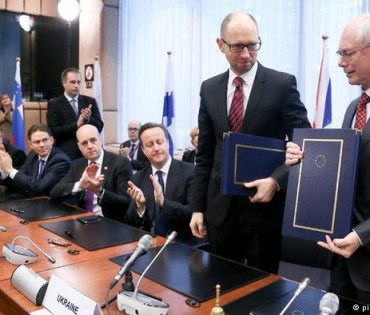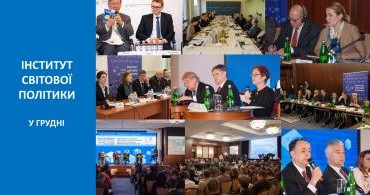Deputy Director of the IWP Kateryna Zarembo for EUObserverWhen Euromaidan started over a year ago, there where three main reasons which took the people to the street: brutal violence of the authorities against peaceful demonstrators, Viktor Yanukovytch’s decline to sign the Association Agreement and the demand for change in Ukraine.\
Out of these three public demands only one has been fulfilled. The Association Agreement has been signed by Ukraine’s authorities in two steps: on March 21 and June 27 2014. The Association Agreement was then ratified by Ukraine and the European Parliament on September 16 2014.
It would seem that this step should be trumpeted by Ukraine’s authorities, applauded by the EU and perceived as the triumph of justice by the democratic societies.
It is not.
One reason for this is the war. Putting the Russian aggression to an end and liberating Ukraine’s territories has occupied hearts and minds of people.
The second reason is the joint actions of the EU and Russia, which applied concerted effort to make sure the value and meaning of the Association Agreement is downplayed as much as possible for the Ukrainian people.
DCFTA as a bargaining chip
Let us briefly recall the events accompanying the AA ratification. To begin with, its most important part (Deep and Comprehensive Free Trade Area and adaptation of Ukraine’s economy to the European standards) was suspended until 1 January 2016 upon Russia’s insistence. This measure was a direct consequence of the Russian aggression on Ukraine’s territory. The joint statement of EU Trade Commissioner De Gucht, Minister of Foreign Affairs of Ukraine Klimkin and Minister of Economic Development of the Russian Federation Ulyukayev says that this measure was taken «to be able to fully support the stabilisation of Ukraine» and that «this ongoing process needs to be part and parcel of a comprehensive peace process in Ukraine». Meanwhile, the parties agree «to address concern raised by Russia».
De facto this means that the provisional application of DCFTA is conditional on the establishment of peace in Ukraine, which, in its turn, is dependent on whatever is going on in Vladimir Putin’s head. There is no guarantee that the DCFTA application could not be postponed even further upon Russia’s insistence.
In addition, Kremlin pledged that, in case Kyiv starts the adaptation of Ukraine’s economy to the European standards before January 1, 2016, legislatively or in practice, it would exempt Ukraine from the preferential trade regime with the Customs Union.
Meanwhile, only 14 EU Member States out of 28 have ratified the Agreement. The ratification of each Member State is necessary for the Agreement to come into force. Until then, the Agreement is considered to be partially applied in those areas which pertain to the competence of the European Union (i.e. selected titles and articles). Thus, the EU isn’t even monitoring the AA implementation yet: according to Deputy Head of the Presidential Administration Dmytro Shymkiv, «the reform monitoring project» is only being designed in cooperation with the Delegation of the European Union to Ukraine.
To sum up, Kyiv, notorious for its reform imitations, has its hands free not to implement their significant part.
Under-carpet reforms
Did Kyiv grab this chance? Not quite.
Immediately after the ratification of the Association Agreement in the Ukrainian Parliament the Implementation Plan for 2014-2017 was approved by the government. Being made up of 488 points, it addresses each clause of the Association Agreement without any exemptions.
Has there been some practical progress? Indeed. It took place even in the economic adaptation sphere, most dreaded by Russia. In particular, three basic laws on technical regulations have been adopted alongside two laws on sanitary and phytosanitary barriers. Importantly, some of these laws were adopted even before the Association Agreement was ratified. The adoption procedure was even faster than it usually takes in Ukraine. Of course, the role of civil society pressure cannot be underestimated in this.
Implementation is the next challenge. The Government Action Plan, adopted in December 2014, is based upon the Association Agreement with the EU alongside the Coalition Agreement. Each minister has a deputy responsible for the European integration of the sector he/she is in charge of. However, no position of the Deputy Prime Minister for European integration has been introduced, thus leaving no executive wholly responsible for the European integration process.
Association Agreement as a security tool
Examining the 488-point Implementation Plan, one more observation comes to mind. 14% of the implementation points pertain to Chapters «Political dialogue and reforms» and «Justice, freedom and security» which hardly make 1% of the Agreement. These include military cooperation, combating terrorism and, ultimately, stressing Ukraine’s sovereignty and territorial integrity. This means that Ukraine sees the Association Agreement as a security, and not only trade and reforming tool.
The question is whether the EU will take up the challenge or pretend it’s Kyiv’s business, as usual.




Comments theme
Comments themeComments themeComments themeComments themeComments themeComments themeComments themeComments themeComments themeComments themeComments themeComments themeComments themeComments themeComments themeComments themeComments themeComments themeComments themeComments.